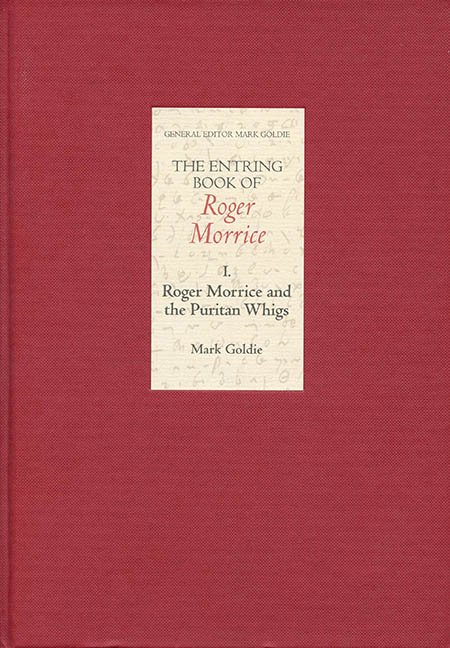Book contents
- Frontmatter
- Contents
- List of Illustrations
- Foreword
- Preface
- Notes on the Editors
- Acknowledgements
- Reader's Guide
- Abbreviations
- Genealogical Tables
- Maps
- Maps
- 1 Politics and Religion in the Era of the Entring Book
- 2 Roger Morrice: Fragments of a Life
- 3 The Text of the Entring Book
- 4 Puritan Whigs
- 5 Country Whigs
- 6 Middle-Way Religion
- 7 The History of the Puritans
- 8 Epilogue: The Entring Book and the Historians
- Appendices
- Bibliography
- Index
- Frontmatter
- Contents
- List of Illustrations
- Foreword
- Preface
- Notes on the Editors
- Acknowledgements
- Reader's Guide
- Abbreviations
- Genealogical Tables
- Maps
- Maps
- 1 Politics and Religion in the Era of the Entring Book
- 2 Roger Morrice: Fragments of a Life
- 3 The Text of the Entring Book
- 4 Puritan Whigs
- 5 Country Whigs
- 6 Middle-Way Religion
- 7 The History of the Puritans
- 8 Epilogue: The Entring Book and the Historians
- Appendices
- Bibliography
- Index
Summary
The spirit of Comprehension
SOBER mediocrity’ was, in the seventeenth century, a term of approval, for ‘mediocrity’ meant a middle way, a balance or mean between extremes. We have seen that in politics the Puritans sought a middle way, repudiating both the absolutism of the Cavaliers and the republicanism of the radicals. They likewise understood themselves to be pursuing a middle way in religion, both in respect of ecclesiology, the theory of the Church, and soteriology, the doctrine of salvation. Their conception of the Church has been touched upon above, but their soteriology has not. This chapter surveys both topics in turn, paying particular attention to the figure who towered over Restoration Puritanism, Richard Baxter.
Modern historiography tends to take for granted that 1662 marked a fundamental divide in the history of English Protestantism. Puritanism gave way to Dissent. The study of Puritanism in the first half of the seventeenth century is assumed to be integral to English history, whereas the study of Dissent is as marginal as the Dissenters themselves are deemed to be. Restoration history is secularised in a way that Jacobean, Caroline, and Cromwellian history is not. As in political history, so in religious history, the Restoration is apt to be regarded scarcely as part of the seventeenth century, but rather of the ‘long eighteenth century’, in which religion entered a continuous stasis that stretched from 1660 until the 1830s. The restored Church of England is identified as stable and becalmed, and Puritanism as deracinated and marginalised. There is of course, in the long view, a persuasive case for this : the Uniformity Act of 1662 was never dislodged (and to this day church noticeboards offer ‘1662’ services) ; the ejected clergy never returned to the fold of the Church. Yet such finality was not apparent before the 1690s. During the Restoration, Puritanism persisted and it still understood itself as a movement within and not outside the national Church.
It tends to be supposed that with the ejections of 1662 there came into existence a more or less ordered array of separate denominations, which we call Dissent or Nonconformity - by the nineteenth century also called the Free Churches. These comprised, principally, the Presbyterians, Congregationalists, Baptists, and Quakers.
- Type
- Chapter
- Information
- The Entring Book of Roger MorriceRoger Morrice and the Puritan Whigs, pp. 225 - 268Publisher: Boydell & BrewerPrint publication year: 2007



